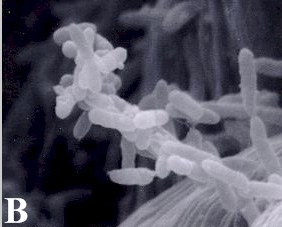Acetobacter: Difference between revisions
No edit summary |
No edit summary |
||
| Line 17: | Line 17: | ||
<h2>Ecology</h2><br /> | <h2>Ecology</h2><br /> | ||
[[Image:Acetobacter2.JPG|left]]Acetobacter bacteria can be found in symbiotic relationships with many different plants, such as sugarcane and coffee plants, as well as in fermenting vinegar. Endophytes are prokaryotes that associate with plants by colonizing their internal tissues. Many of these bacteria have been observed to promote plant growth, but the mechanisms behind this relationship are not yet fully understood. Below is a table of places where A. diazotrophicus can be found. | [[Image:Acetobacter2.JPG|left]]Acetobacter bacteria can be found in symbiotic relationships with many different plants, such as sugarcane and coffee plants, as well as in fermenting vinegar. Endophytes are prokaryotes that associate with plants by colonizing their internal tissues. Many of these bacteria have been observed to promote plant growth, but the mechanisms behind this relationship are not yet fully understood. Below is a table of places where A. diazotrophicus can be found. | ||
{| border="1" | |||
|- | |||
| Sugarcane | |||
| root, root hair, stem, leaf | |||
|- | |||
| Cameroon grass | |||
|root, stem | |||
|- | |||
|Sweet potato | |||
|root, stem tuber | |||
|- | |||
|Coffee | |||
|root, rhizosphere, stem | |||
|- | |||
|Ragi | |||
|root, rhizosphere, stem | |||
|- | |||
|Tea | |||
|root | |||
|- | |||
|Pineapple | |||
|fruit | |||
|- | |||
|Mango | |||
|fruit | |||
|- | |||
|Banana | |||
|rhizosphere | |||
|- | |||
|Others - mealy bugs, VAM spores | |||
|internal environment | |||
|} | |||
Revision as of 19:24, 23 May 2006
Classification
Higher order taxa:
Bacteria; Proteobacteria; Alphaproteobacteria; Rhodospirillales; Acetobacteraceae
Species:
Acetobacter calcoaceticus; Acetobacter cerevisiae; Acetobacter cibinongensis; Acetobacter diazotrophicus; Acetobacter estunensis; Acetobacter indonesiensis; Acetobacter lovaniensis; Acetobacter malorum; Acetobacter orientalis; Acetobacter orleanensis; Acetobacter pasteurianus; Acetobacter peroxydans; Acetobacter polyoxogenes; Acetobacter pomorum; Acetobacter subgen. Acetobacter aceti; Acetobacter syzygii; Acetobacter tropicalis; Acetobacter sp.
Description and Significance
Acetobacter bacteria, such as Acetobacter diazotrophicus that can be isolated from coffee plants or sugarcane, are acid-producing, nitrogen-fixing bacteria. In fact, the A. diazotrophicus-sugarcane relationship, first observed in Brazil, was the first report of a beneficial symbiotic relationship between grasses and bacteria through nitrogen fixation. Nitrogen-fixing bacteria are important in modern agriculture - exploiting these bacteria would decrease the present dependency on nitrogen fertilizers, which would have positive results for the ecosystem and the health of humans and other animals. Other strains can be found in samples from Japanese rice vinegar (komesu) or unpolished rice vinegar (kurosu).
Genome Structure
Acetobacter bacterial genomes currently have yet to be sequenced.
Cell Structure and Metabolism
Acetobacter is an obligatory aerobic, nitrogen-fixing bacteria that is known for producing acid as a result of metabolic processes. While all nitrogen-fixing bacteria contain nitrogenase in order to utilize atmospheric nitrogen gas as a source for metabolic biosynthesis, different nitrogen-fixing microorganisms protect the oxygen-sensitive microorgansims from oxygen exposure in different ways. A. diazotrophicus has been called interesting because it carries out nitrogen fixation under aerobic conditions. It needs oxygen for the production of large quantities of ATP required for nitrogen fixation; however, little is known about the mechanism or system that protects the the nitrogenase under aerobic conditions. A. diazotrophicus is a plant endophyte and has been said to be capable of excreting about half of its fixed nitrogen in a form that plants can use.
Ecology
Acetobacter bacteria can be found in symbiotic relationships with many different plants, such as sugarcane and coffee plants, as well as in fermenting vinegar. Endophytes are prokaryotes that associate with plants by colonizing their internal tissues. Many of these bacteria have been observed to promote plant growth, but the mechanisms behind this relationship are not yet fully understood. Below is a table of places where A. diazotrophicus can be found.
| Sugarcane | root, root hair, stem, leaf |
| Cameroon grass | root, stem |
| Sweet potato | root, stem tuber |
| Coffee | root, rhizosphere, stem |
| Ragi | root, rhizosphere, stem |
| Tea | root |
| Pineapple | fruit |
| Mango | fruit |
| Banana | rhizosphere |
| Others - mealy bugs, VAM spores | internal environment |


